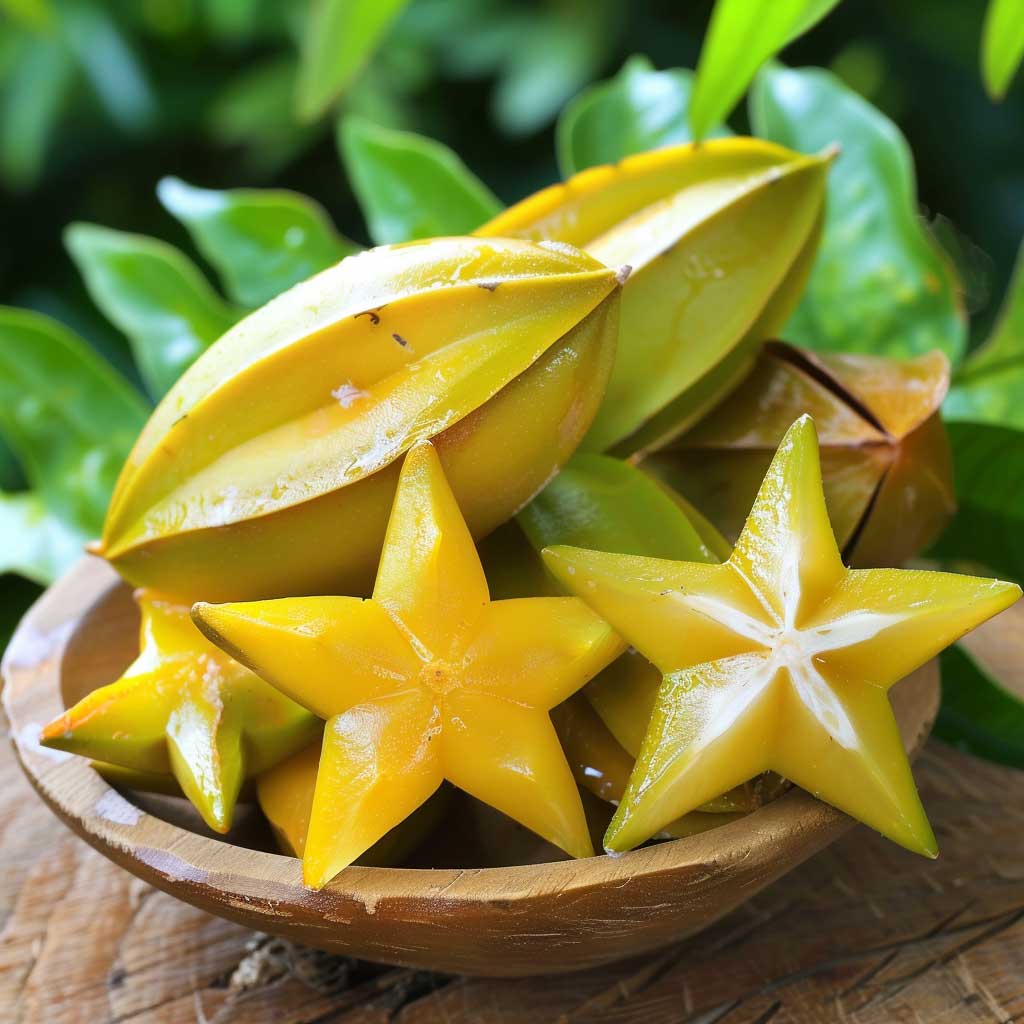Star fruit, scientifically known as Averrhoa carambola, or simply carambola, is a luscious tropical fruit originating from India and Southeast Asia, where it thrives in warm, humid conditions and is extensively cultivated. It is distinctive yellow, star-shaped appearance characterizes this fruit, which flourishes on trees across India, Asia, South America, Australia, and in select regions of the United States.
Despite its lesser-known status in the U.S., where it is often used decoratively in cocktails or salads due to its visually appealing shape, star fruit enjoys widespread popularity worldwide, being utilized in both raw and cooked culinary applications. Its taste profile provides a delightful blend of slight sweetness and tanginess, reminiscent of a ripe pear, green grape, and orange. With juicy, firm flesh akin to that of a grape, star fruit stands out as a unique and versatile addition to global cuisine.
Guidelines for Selecting Star Fruit:
Opt for firm carambolas showcasing bright yellow or yellow-green skin; slight browning on the edges is acceptable. Avoid predominantly green fruits, as they are underripe. Overripe carambolas display a dark yellow hue with brown spots throughout.

The sustainability of star fruit
Growing star fruit in the U.S., particularly in regions cooler and drier than its native habitat, presents challenges. The plant demands nutrient-rich soil and is susceptible to cooler temperatures and wind. Despite these obstacles, Florida has fostered a significant commercial star fruit industry since the 1970s, offering an alternative to citrus and avocado crops. Presently, researchers are exploring the potential of cover crops to enhance fruit growth while reducing fertilizer usage, promoting soil biodiversity and fertility.
Chemical Pest Control
Star fruit plants are vulnerable to certain insect pests like aphids and mites. While some commercial producers resort to pesticides for control, growers employing biological methods, such as introducing predatory wasps, have achieved positive results. To minimize the risk of exposure to harmful chemicals, opt for organic star fruit whenever available.
Water
Given that star fruits originate from subtropical and tropical regions, they have a high demand for water.
Geography
Commercial cultivation of carambola spans across Southeast Asia, Australia, and South America. In the Southern United States, particularly Florida, which accounts for roughly 90 percent of U.S. production, and in Hawai’i, it is also grown commercially.
Storage Instructions
When you purchase a green carambola, allow it to sit at room temperature, shielded from sunlight, for several days until it transforms into a yellow hue. If the star fruit displays brown ridges, refrigerate it for a maximum of four days to prevent excessive ripening. Overripe fruit is characterized by widespread brown spots and may possess a fermented taste.
Seasonality
In South Florida, star fruits are typically harvested in two distinct periods: from August to September and from December to February. Depending on the planting schedule of growers, local availability of the fruit is often consistent throughout the year.
Preserving Star Fruit

Fresh carambola has a short shelf life of just a few days. To extend its freshness, consider various preservation methods. Puree and freeze the fruit, ensuring it remains viable for up to four months. Alternatively, transform it into delectable chips through dehydration, pickle it for a tangy twist, or utilize it in homemade jams or marmalades.
Cooking with Star Fruit
Star fruit is incredibly versatile, lending itself to a multitude of culinary applications, whether sweet or savory, raw or cooked. It’s a beloved ingredient in fruit salads, compotes, smoothies, beverages, and cocktails. Its uses extend to baking, such as in the delightful star fruit upside-down cake, and it adds a unique twist to savory dishes, pairing beautifully with chicken, shrimp, and other main courses.

Originating from Asia, this fruit features prominently in various regional cuisines, enhancing dishes like Indian curries, the Goan chutney Karmalache Goad Mel, Vietnamese sour soup, and many more.
Indulging in Star Fruit
Consuming star fruit is a straightforward process as the entire fruit, including its waxy skin, is edible, allowing for effortless raw consumption. To prepare the fruit, place it on a cutting board and carefully slice along each of the five ridges, discarding the brown outer edge. Holding the star fruit horizontally, slice it crosswise into your preferred thickness, resulting in star-shaped pieces. Use the knife tip to remove any seeds. While the fruit can be further sliced into smaller pieces, retaining its iconic shape adds to the enjoyment of this tropical delicacy.
Health Benefits

Star fruit is a low-calorie food packed with fiber and rich in Vitamins A and C. However, it is important to be aware that the fruit also contains oxalic acid and caramboxin, which may pose risks for individuals with kidney issues or those on blood pressure medication. Despite this, for most people, star fruit remains a safe and nutritious choice.
